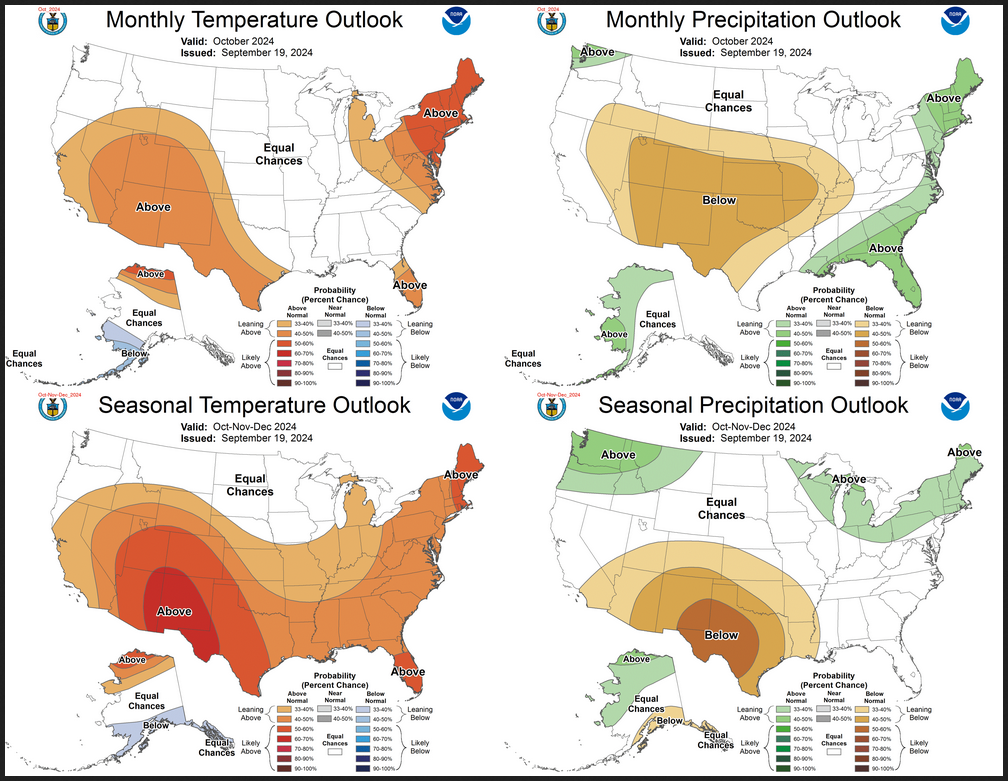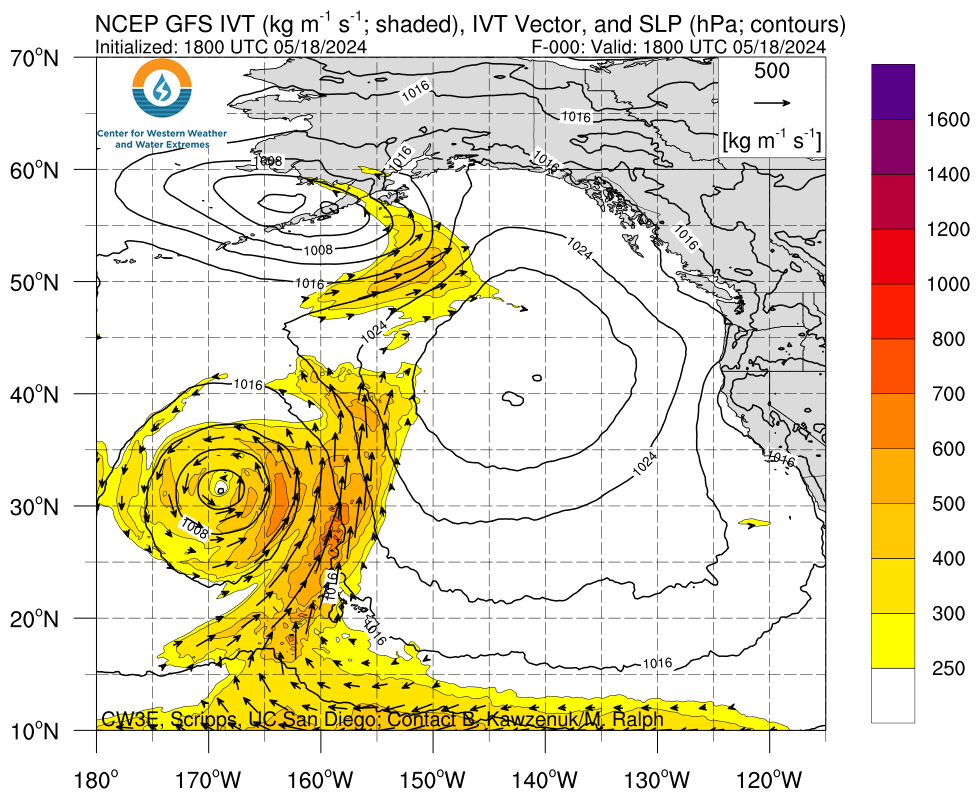This article focuses on what we are paying attention to in the next 48 to 72 hours. The article also includes weather maps for longer-term U.S. outlooks (up to four weeks) and a six-day World weather outlook which can be very useful for travelers.
First the NWS Short Range Forecast. The afternoon NWS text update can be found here after about 4 p.m. New York time but it is unlikely to have changed very much from the morning update. The images in this article automatically update.
Short Range Forecast Discussion
NWS Weather Prediction Center College Park MD
Tue Sep 24 2024
Valid 12Z Tue Sep 24 2024 – 12Z Thu Sep 26 2024…Potential Tropical Cyclone Nine is forecast to pass not too far from
the Florida Keys Wednesday night as a hurricane before skirting up the
West Coast of Florida by Thursday morning……Much needed rainfall from the Ohio Valley into the central to southern
Appalachians, Upper Tennessee Valley and Mid-Atlantic……Much above average temperatures continue across the West into the
Northern Plains and across the Gulf Coast into the Southeast…A relatively benign mid- to upper-level trough that will likely bring
beneficial rainfall for the eastern U.S. is forecast to deepen when
another upper-level trough over the northern Plains drops southeast and
merges with the lead trough. The resulting trough amplification will be
instrumental in pulling the tropical moisture as well as Potential Cyclone
Nine (PTC9) northward into the eastern portion of the Gulf of Mexico by
the end of the short-range forecast period on Thursday morning.The initial impacts from the lead trough will be in the form of an
expanding area of moderate to heavy rainfall potential from the Midwest
into the lower Great Lakes, Ohio Valley, upper Tennessee Valley, central
to southern Appalachians into the Mid-Atlantic near and ahead of a low
pressure wave. Much of these areas are currently experiencing severe to
exceptional drought conditions, with the expected 1 to 1.5 inch plus
rainfall amount over the next two days bringing some relief to these
drought conditions. With the dry conditions across these areas, river
flooding will be unlikely. However, there is still at least a marginal
risk of isolated flash flooding with the expected heavy rainfall amounts,
especially if they occur over urbanized regions.As the above-mentioned amplifying pattern develops over the northern
Plains and dips toward the Deep South, PTC9 is forecast to track more
toward the north and intensify rapidly as it moves across the Yucatan
Channel on Wednesday and then pass not too far from the Florida Keys
Wednesday night. The Florida Keys can expect strengthening winds with
more frequent passages of squally downpours Wednesday night as PTC9 is
forecast to pass to the west as a hurricane. Computer models indicate
that the circulation of PTC9 will expand as it interacts with the
deepening upper trough in the Deep South. Given a more robust convective
structure concentrated more on the east side of the storm, the West Coast
of Florida could begin to see more frequent and intense squalls with winds
further strengthening by Thursday morning. Please refer to the National
Hurricane Center for the latest updates on this system.The amplifying upper ridge across the interior West will be supporting
widespread much above average temperatures over the next few days across
nearly all of the West and into the Northern Plains. High temperatures
across these regions are forecast to be as much as 10 to 20 degrees above
average. Above average temperatures also likely across the Gulf Coast and
into the Southeast. While temperatures are forecast to be much above
across these areas over the next few days, there are not expected to be
many record highs. However, more numerous record high morning
temperatures are possible both today and Wednesday morning along the West
coast and from portions of the southern Mid-Atlantic into the Southeast
and Florida. Across the Pacific Northwest, the cold front associated
with a Pacific cyclone centered over the Gulf of Alaska will only bring
some rainfall into the region by Wednesday.
To get your local forecast plus active alerts and warnings click HERE and enter your city, state or zip code.
Learn about wave patterns HERE.
Then, looking at the world and of course, the U.S. shows here also. Today we are looking at precipitation.
Please click on “Read More” below to access the full Daily Report issued today.
| Notices: What would you like to learn about? Please provide that to me via the comment section at the end of the article. |
Before we get started on this, I want to include the key graphic from the Updated Four Season Outlook that we discussed HERE yesterday.
The top row is what is now called the Mid-Month Outlook for next month which will be updated at the end of this month. There is a temperature map and a precipitation map. The second row is a three-month outlook that includes next month.
Now more detail on the 48-Hour Forecast (It is a 48 to 72 Hour Forecast actually)
Daily weather maps. The Day 1 map updates twice a day and the Day 2 and 3 maps update only once a day. These maps update automatically. But if that does not happen, you can get updates by clicking HERE
TODAY (or late in the day the evening/overnight map will appear) (Key to surface fronts shown on maps and you will then also be able to insert a city name or zip code and get a local NWS forecast).
TOMORROW
NEXT DAY
We have a new animation of the forecast which shows how things may play out over the next 60 hours. To update click ANIMATION. Doing so will get you to the dashboard. You can then step through the animation or hit LOOP on the upper right of the display. You will have to hit the back arrow ← at the top left on your computer to get back into this article. It is a little more trouble than before but I think NOAA scrapped the animation routine I was using so we have to keep up with “progress”.
The NWS Climate Prediction Center’s: Watches, Warnings, and Advisories plus other information can be found HERE. That takes you to the NWC Severe Weather Site. From there you can select among many categories of information. Remember to hit the back arrow ← at the top left of your screen to return to this article.
ATMOSPHERIC RIVERS
This tells us what is approaching the West Coast. Click HERE to update If I have not gotten around to doing the update. Here is some useful information about Atmospheric Rivers.
Below is the current five-day cumulative forecast of precipitation (Updates can be found HERE)

Ski SnowReports will Resume in the Fall.
Now we look at Intermediate-Term “Outlook” maps for three time periods. Days 6 – 10, Days 8 – 14, and Weeks 3 and 4. An outlook differs from a forecast based on how NOAA uses these terms in that an “outlook” presents information as deviation from normal and the likelihood of these deviations.
Below are the links to obtain updates and additional information. They are particularly useful if you happen to be reading this article significantly later than when it was published. I always try to provide readers with the source of the information in my articles. These links may also be useful for those viewing this article on a cell phone or other small screen.
| Days 6 – 10 (shown in Row 1) | Days 8 – 14 (Shown in Row 2) | Weeks 3 and 4 (Shown in Row 3 but updates only on Fridays) |
| https://www.cpc.ncep.noaa. gov/products/predictions/610day/ | https://www.cpc.ncep .noaa.gov/products/predictions/814day/ | https://www.cpc.ncep.noaa.gov/products/predictions/WK34/ |
Showing the actual maps. They should now update automatically. The Week 3 – 4 Outlook only updates on Fridays. So below is what I call the Intermediate-term outlook. On Fridays, it extends out 28 Days. That declines day by day so on Thursday it only looks out 22 days until the next day when the Week 3 – 4 Outlook is updated and this extends the outlook by one additional week.
| 6–
10
|
|
|
| 8–
14 |
|
|
| 3–
4 |
|
|
HAZARDS OUTLOOKS
Click here for the latest complete Day 3 -7 Hazards forecast which updates only on weekdays. Once a week probably Monday or Tuesday I will update the images. I provided the link for readers to get daily updates on weekdays. Use your own judgment to decide if you need to update these images. I update almost all the images Friday Night for the weekend edition of this Weather Report. So normally readers do not need to update these images but if the weather is changing quickly you may want to.

Temperature month to date can be found at https://hprcc.unl.edu/products/maps/acis/MonthTDeptUS.png
Precipitation month to date can be found at https://hprcc.unl.edu/products/maps/acis /MonthPNormUS.png
World Forecast [that website is has been intermittent so be patient]
Below are the Day 1 -3 and 4-6 forecasts for temperature and precipitation. Updates and much additional information can be obtained HERE
World Temperature Anomalies


World Accumulated Precipitation


This information is provided by the University of Maine. They draw upon many different sources. There is a lot of information available at the link provided. I have just provided two useful forecasts. There are probably over a hundred different forecasts available from this source.
Worldwide Tropical Forecast (This is a NOAA Product)
This graphic updates on Tuesdays) If it has not been updated, you can get the update by clicking here Readers will only have to do that if they are reading this article much later than the date of it being published.
Information on Tropical Storms can be found HERE. Western Pacific information can be found HERE. Note that unless there is an out-of-season storm the below images will not update until the National Hurricane Center starts their seasonal update of these maps on June 1. I include them simply because there can be an out-of-season event in which case it should show up in these maps.


–
| I hope you found this article interesting and useful. |










